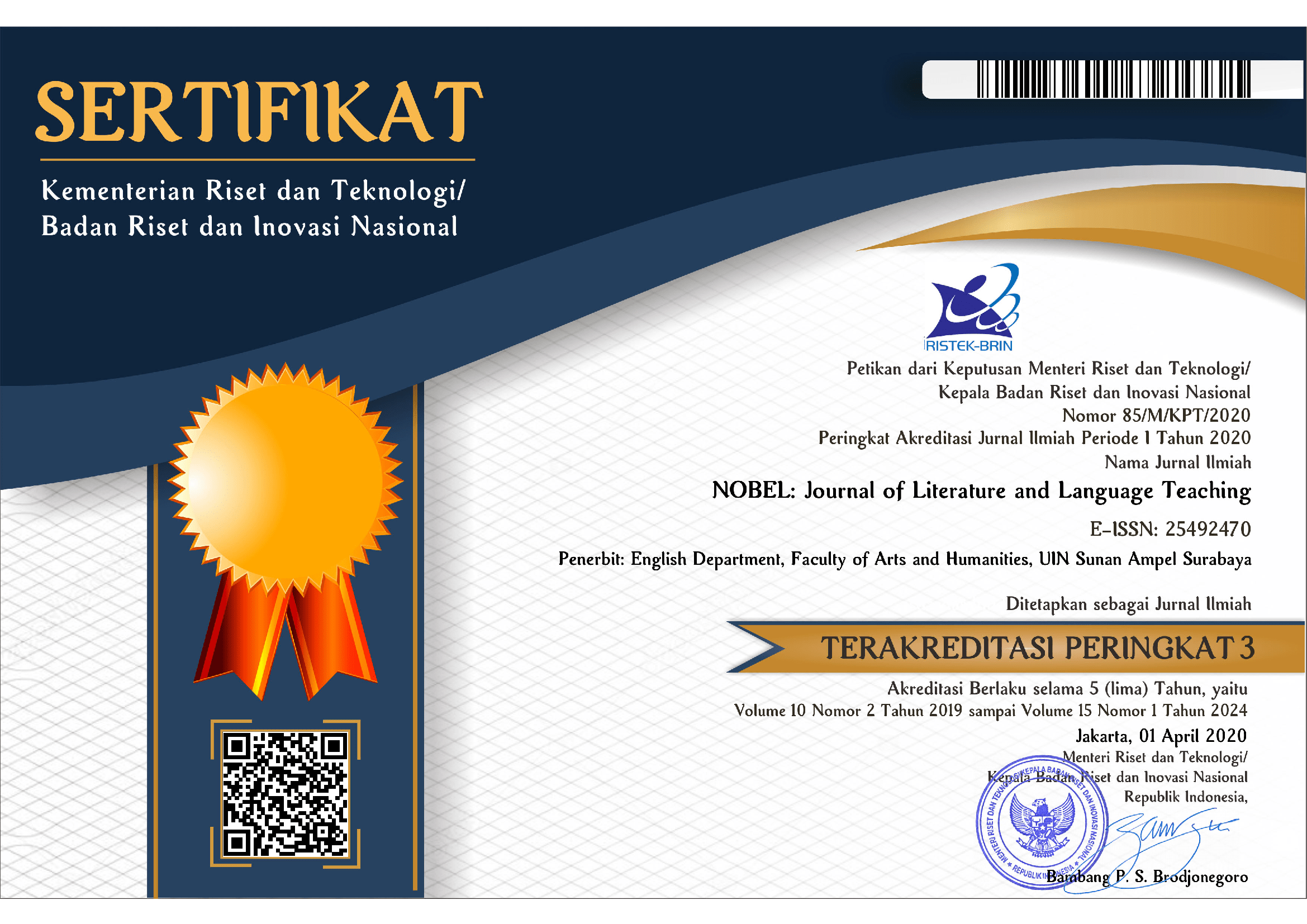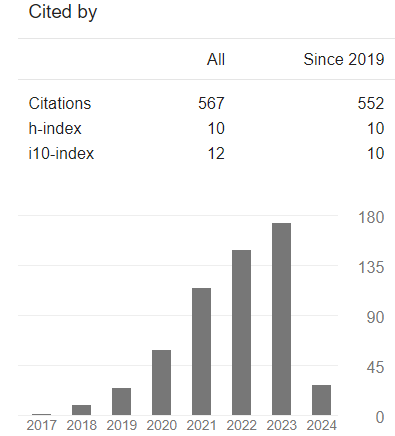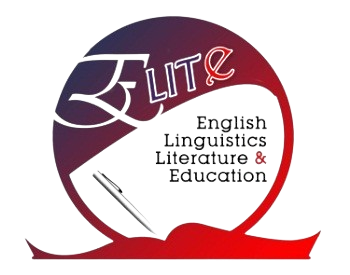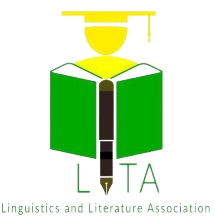Language Education and Systemic Functional Linguistics
A State-of-the-art-review
DOI:
https://doi.org/10.15642/NOBEL.2020.11.2.234-249Keywords:
appliable linguistics; language education; pedagogical implications; Systemic Functional LinguisticsAbstract
The purpose of the present paper is to offer a state-of-the-art review on the topic of Systemic Functional Linguistics (SFL) and its theoretical and practical implications on the field of language education, being the former widely recognized due to its potentiality to encourage both reflection and action for the participants involved. Recent empirical studies were located and thoroughly reviewed, which shed light on the three most researched areas including text analysis and literacy intervention, classroom discourse, and the language teaching and learning processes. As a final remark and taking into account the literature analysis, some prospective studies are briefly proposed.
Downloads
References
Achugar, M., Schleppegrell, M., & Oteíza, T. (2007). Engaging teachers in language analysis: A functional linguistics approach to reflective literacy. English Teaching: Practice and Critique, 6(2), 8-24. Retrieved from https://files.eric.ed.gov/fulltext/EJ832185.pdf
Adetomokun, I.J. (2012). A Systemic Functional Linguistics (SFL) Analysis of Yoruba Students’ Narratives of Identity at Three Western Cape Universities. Master thesis. University of the Western Cape. Retrieved from: http://etd.uwc.ac.za/bitstream/handle/11394/3290/Adetomokun_MA_2012.pdf?sequence=1&isAllowed=y
Arús, J., Bárcena, E., & Rodríguez, P. (2010). Fostering intercultural competence through contextualized texts in EFL settings. Congreso Mapping Language Across (MLAC-2010). Salamanca: Ediciones Universidad de Salamanca.
Assalahi, H. (2013). Why Is the grammar-translation method still alive in the Arab World? Teachers ?beliefs and its implications for EFL teacher education. Theory and Practice in Language Studies, 3(4), 589-599. Retrieved from http://www.academypublication.com/issues/past/tpls/vol03/04/06.pdf
Badklang, C., & Srinon, U. (2018). Analysis of attitudinal resources in an EFL university classroom talk in the deep South of Thailand: An appraisal perspective. The New English Teacher, 2(2), 106-128.
Barwell, R. (2016). A Bakhtinian perspective on language and content integration: Encountering the alien word in second language mathematics classrooms. In T. Nikula, E. Dafouz, P. Moore, & U. Smit, Conceptualising integration in CLIL and multilingual education (pp. 101-122). Great Britain: Multilingual Matters.
Berry, M. (2013). The difference between formal written and informal spoken English. In L. Fontaine, Systemic functional linguistics: Exploring choice (pp. 365–383). Cambridge: Cambridge University Press.
Brown, D. (2007). Teaching by principles: An interactive approach to language pedagogy. New York: Pearson Education.
Byrnes, H. (2008). Articulating a foreign language sequence through content: A look at the culture standards. Language Teaching, 41(1), 103–118. DOI: 10.1017/S0261444807004764
Caamaño, A. (n.d.). Aportes del paradigma sistémico funcional para el desarrollo de la comprensión lectora. Jornadas Nacionales sobre Pedagogía de la Formación del Profesorado: Investigar las prácticas para mejorar la formación: metodologías y problemas, (pp. 1-7).
Correa, D., & Domínguez, C. (2014). Using SFL as a tool for analyzing students' narratives. How, 21(2), 112-133. doi:https://dx.doi.org/10.19183/how.21.2.7
Christie, F. (2004). Systemic functional linguistics and a theory of language in education. Ilha do Desterro A Journal of English Language, Literatures in English and Cultural Studies(46), 13-40. DOI: 10.5007/%x
Derewianka, B. (2003). Grammatical metaphor in the transition to adolescence. In A.-M. Simon-Vandenbergen, M. Taverniers, & L. Ravelli, Grammatical Metaphor: Views from systemic functional linguistics (pp. 185-220). Philadelphia: John Benjamins Publishing Company.
de Oliverira, L., & Schaleppegrell, M. (2015). Grammar and meaning. In L. de Oliverira, & M. Schaleppegrell, Focus on Grammar and Meaning. England: Oxford University Press.
Eggins, S. (1994). An introduction to systemic functional linguistics. London: Pinter.
Ellis, R. (1995). Interpretation tasks for grammar teaching. TESOL Quarterly, 29(1), 87-105. Retrieved from https://www.jstor.org/stable/3587806?seq=1
Estiyowati, R. (2017). The implementation of functional grammar in English teaching and learning. Conference on Language and Language Teaching. Innovation in language and language teaching in the 21st Century (pp. 120-124). Magelang: Universitas Tidar.
Firth, J. (1950). Personality and language in society. Papers in linguistics. Oxford University Press. pp. 177–189.
Firth, J. R. (1957). Papers in linguistics. 1934–1951. Oxford University Press.
García, P., Sagre, A., & Lacharme, A. (2014). Systemic functional linguistics and discourse analysis as alternatives when dealing with texts. PROFILE, 16(2), 101-116. DOI: 10.15446/profile.v16n2.38113
Gibbons, P. (2003). Mediating language learning: Teacher interactions with ESL students in a content?based classroom. TESOL Quarterly, 37(2), 247-273.
Halliday, M. (1985). An introduction to functional grammar. London: E. Arnold.
Halliday, M. (1973). Explorations in the functions of language. London: Edward Arnold.
Halliday, M. & Hassan, R. (1976). Cohesion in English. London: Pearson Education Limited.
Halliday, M. (1978). Language as social semiotic: The social interpretation of language and meaning. London: Edward Arnold.
Halliday, M. (1992). The notion of 'context' in language education. In T. Le, & M. McCausland, Interaction and development: Proceedings of the International Conference (pp. 1-26). Vietnam: Language Education.
Halliday, M. (1993). Towards a language-based theory of learning. Linguistics and Education, 5(2), 93-116. Retrieved from http://lchc.ucsd.edu/mca/Paper/JuneJuly05/HallidayLangBased.pdf
Halliday, M., & Martin, J. (1993). Writing science. Literacy and discursive power. London: The Falmer Press.
Halliday, M. (1994). An Introduction to Functional Grammar. London: Edward Arnold.
Halliday, M. (2002). M.A.K. Halliday. In K. Brown, & V. Law, Linguistics in Britain: personal histories (pp. 116-126). Oxford: Blackwell.
Halliday, M., & Hasan, R. (2006). Retrospective on SFL and literacy. In R. Whittaker, M. O’Donnel, & A. McCabe, Language and literacy: Functional approaches (pp. 15-44). London: Bloomsbury.
Halliday, M. (2007). Introduction. In M. Halliday, Language and education (pp. 1-19). London: Continuum.
Hasan, R. (1985). Linguistics, language and verbal art. Geelong, Victoria, Aus.: Deakin University Press.
Hasan, R. (1986). The ontogenesis of ideology: An interpretation of mother-child talk. In T. Threadgold, Semiotics - Ideology - Language (pp. 125-146). Sydney: Sydney Association for Studies in Society and Culture.
Hasan, R., & Martin, J. (1989). Language development: learning language, learning culture. Meaning and choice in language: Studies for Michael Halliday. Norwood, N.J: Ablex.
Hasan, R. (1996). Ways of Saying: Ways of Meaning. London: Cassell.
Hinkel, E., & Fotos, S. (2002). From theory to practice: Teachers’ view. In E. Hinkel, & S. Fotos, New perspectives on grammar teaching in second language (pp. 1-12)). London: Lawrence Erlbaum.
Jeong, H., & Lo, Y. (2017). Impact of genre-based pedagogy on students' academic literacy development in Content and Language Integrated Learning (CLIL). CAES International Conference. Hong Kong: Centre for Applied English Studies, University of Hong Kong.
Larsen-Freeman, D. (2000). Techniques and principles in language teaching. New York: Oxford University Press.
Li, X. (2016). A functional analysis of hedges in teacher talk. Studies in Literature and Language, 12(1), 46-49.
Lim, F. (2019). Investigating intersemiosis: a systemic functional multimodal discourse analysis of the relationship between language and gesture in classroom discourse. Visual Communication, 1-25. Retrieved from https://journals.sagepub.com/doi/pdf/10.1177/1470357218820695
Lim, V. (2018). Developing a systemic functional approach to teach multimodal literacy. Functional Linguist, 5(13).
Malinowski, B. (1923). The Problem of Meaning in Primitive Languages. In C. K. Ogden, & I. A. Richards (Eds.), The Meaning of Meaning, pp. 296-336. London: K. Paul, Trend, Trubner.
Malinowski, B. (1935). Coral Gardens and Their Magic. A Study of the Methods of Tilling the Soil and of Agricultural Rites in the Trobriand Islands. In The description of gardening. The language of magic and gardening. London: George Allen & Unwin.
Martin, J., & Rose, D. (2003). Working with discourse: Meaning beyond the clause. London: Continuum.
Martin J. (2010). Systemic Functional Linguistic Theory. Vol. 1: Collected Works of J R Martin (Wang Zhenhua Ed.). Shanghai: Shanghai Jiao Tong University Press.
Martin, J. (2014). Evolving systemic functional linguistics: Beyond the clause. Functional Linguistics, 1(3).
Matthiessen, C. (2007). The 'Architecture' of language according to systemic functional theory: developments since the 1970s. In R. Hasan, C. Matthiessen, & J. J. Webster (Eds.), Continuing discourse on language: a functional perspective (pp. 505-561). London: Equinox Publishing.
Matthiessen, C., & Halliday, M. (2009). Systemic functional grammar: A first step into the theory. Beijing: Higher Education Press.
Matthiessen, C. (2015). Halliday on language. In J. J. Webster (ed.), The Bloomsbury companion to M A K Halliday, 137–202. London: Bloomsbury.
Maton, K. & Doran, Y. (2017) Systemic Functional Linguistics and code theory. In T. Bartlett & G. O’Grady (Eds.) The Routledge Handbook of Systemic Functional Linguistics. London: Routledge. 605-618
Maxwell-Reid, C. (2011). The Challenges of Contrastive Discourse Analysis: Reflecting on a Study into the Influence of English on Students’ Written Spanish on a Bilingual Education Program in Spain. Written Communication, 28(4), 417-435. DOI: 10.1177%2F0741088311421890
McCrocklin, S., & Slater, T. (2017). A model for teaching literary analysis using systemic functional grammar. Texas Journal of Literacy Education, 5(1), 81-96.
Nagao, A. (2019). The SFL genre-based approach to writing in EFL contexts. Asian-Pacific Journal of Second and Foreign Language Education, 4(6), 2-18.
Oldenburg, J. (1986). The transitional stage of a second child-18 months to 2 years. Australian Review of Applied Linguistics, 9, 123- 135.
Oliveira, L. (2015). A systemic-functional analysis of English language learners' writing. DELTA, 31(1), 207-237. DOI:https: 10.1590/0102-4450364601799092306
Painter, C. (1996). The development of language as a resource for thinking: A linguistic view of learning. In R. Hasan, & G. William, Literacy in society. London: Longman.
Potradinata, S. (2018). An analysis of student’s descriptive text writing in systemic functional linguistic (SFL) perspectives. International Journal of Languages, Literature and Linguistics, 4(2), 125-131. Retrieved from http://www.ijlll.org/vol4/161-LA1034.pdf
Prasiyanto, S. (2018). Teaching L2 writing through the use of Systemic Functional Linguistics (SFL). Indonesian Journal of English Language Teaching, 13(1). DOI: 10.25170%2Fijelt.v13i1.1179
Putra, D., & Lukmana, I. (2017). Text complexity in senior high school English textbooks: A systemic functional perspective. Indonesian Journal of Applied Linguistics, 7(2), 436-444. DOI: 10.17509/ijal.v7i2.8352
Rodríguez, P. (2013). The use of SFL gender theory for the analysis of students' writing skills in ESP. Volumen Monográfico, 245-262.
Rojas-García, I. (2016). Aportes de la lingüística sistémico-funcional para la enseñanza de la lectura y la escritura en la educación superior. Educacion y Educadores, 19(2), 185-204. DOI: 10.5294/edu.2016.19.2.1
Sagre, A., & Herazo, J. (2015). Generic, discourse, and lexicogrammatical characteristics of a listening exercise in an EFL classroom. Íkala, Revista de Lenguaje y Cultura, 20(1), 113-127. Retrieved from http://www.scielo.org.co/pdf/ikala/v20n1/v20n1a7.pdf
Schleppegrell, M.J. (2004). The language of schooling: A functional linguistics perspective. New Jersey: Lawrence Erlbaum Associates, Inc., Publishers
Schulze, J. (2015). Academic language, English language learners, and systemic functional linguistics: Connecting theory and practice in teacher education. The CATESOL Journal, 27(1), 109-130.
Sharwood, S. (1981). Consciousness-raising and the second language learner. Applied, 2(2), 159-168.
Shawana, F., Muhammad, M., & Mustanir, A. (2016). Integration of grammar translation method with communicative approach: A research synthesis. International Research Journal of Arts and Humanities, 44(44), 121-130.
Shenderuk, O., Tamarkina, O., & Tetiana, P. (2018). Grammar-Translation and direct methods in teaching English in the educational institution with specific conditions of study. The Journal of Social Sciences Research, (5), 529-534.
Somers, T., Llinares, A., & Morton, T. (2016). The development of academic language proficiency in the CLIL classroom. International Conference on Bilingualism in Education. Gwynedd.
Sunardi, S., Tarjana, M., Poedjosoedarmo, S., & Santosa, R. (2018). Interpersonal realizations of pedagogic discourse in Indonesian EFL classrooms. International Journal of Language Teaching and Education, 2(3), 205-215. DOI: 10.22437/ijolte.v2i3.5678
Taylor, R. (2014). Meaning between, in and around words, gestures and postures – multimodal meaning-making in children's classroom discourse. Language and Education, 28(5), 401-420. DOI: 10.1080/09500782.2014.885038
Torr, J., & Simpson, A. (2003). The emergence of grammatical metaphor: literacy-oriented expressions in the everyday speech of young children. In A.-M. Simon-Vandenbergen, M. Taverniers, & L. Ravelli, Grammatical Metaphor: Views from systemic functional linguistics (pp. 169-184). Philadelphia: John Benjamins Publishing Company.
Tshotsho, B. (2014). Assessing students' academic writing using systemic functional linguistics at a university in South Africa. International Journal of Educational Sciences, 6(3), 425-433. DOI:https: 10.1080/09751122.2014.11890154
Tucker, G. (n.d.). LLAS Centre for Languages, Linguistics and Area Studies. Retrieved from Systemic functional linguistics in language education: https://www.llas.ac.uk/resources/gpg/103.html
Vidal, M. (2017). Knowledge in your classroom: A model of analysis for specialization codes in classroom discourse. Onomázein Special Issue SFL and LCT on Education and Knowledge. Revista semestral de lingüística, filología y traducción, 149-178. DOI: 10.7764/onomazein.sfl.06
Whittaker, R. (2010). Using systemic-functional linguistics in content and language integrated learning. NALDIC Quarterly, 8(10), 31–36.
Whorf, B. (1952) Language, Mind and Reality. A Review of General Semantics, 9. pp. 167–188.
Whorf, B. (1956). Language, Thought, and Reality: Selected Writings of Benjamin Lee Whorf. Carroll J. (Ed.). MIT Press
Willis, D. (2003). Rules, patterns and words: Teaching English grammar and vocabulary. London: Longman.
Yang, X., & Tao, X. (2018). Comparing discourse behaviors of a high?rated and a low?rated Chinese EFL teacher: A systemic functional perspective. The Modern Language Journal, 102(3), 594–610.







